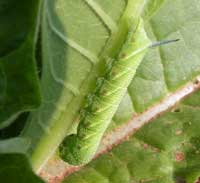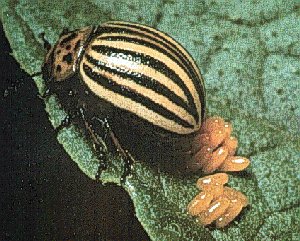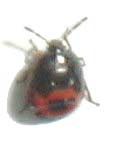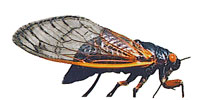

JAPANESE BEETLES beginning to feed on a wide range of crops and plants;
CUCUMBER BEETLES, SQUASH BUGS and SQUASH VINE BORERS;
COMMON STALK BORER damage;
GALLS apparent on shade trees, especially oaks;
BAGWORMS on deciduous and evergreen landscape plantings;
dump standing water that could serve as MOSQUITO breeding sites


 Tobacco growers looking for alternatives to acephate (Orthene) or endosulfan (Thiodan) for tobacco insect control have several choices to consider. Bt products (Agree, Dipel, Lepinox, etc.) are specific for caterpillars - hornworms and budworms - but have a relatively short residual life after application. They are effective when pests are present and in the earlier stages of development but will not provide extended preventive control.
Tobacco growers looking for alternatives to acephate (Orthene) or endosulfan (Thiodan) for tobacco insect control have several choices to consider. Bt products (Agree, Dipel, Lepinox, etc.) are specific for caterpillars - hornworms and budworms - but have a relatively short residual life after application. They are effective when pests are present and in the earlier stages of development but will not provide extended preventive control.
Tracer (spinosad) is labeled for budworms and hornworms and has a 3 day harvest restriction. Denim (emamectin benzoate) also is a caterpillar insecticide that has a 14 day harvest interval.
The pyrethroid Warrior (cyhalothrin) has a relatively long residual life following application and wide pest control spectrum, caterpillars, beetles, stink bugs, etc. There is a 40 day harvest interval for this Restricted Use insecticide.
 As of June 23, three states have reported at least one case of blue mold on tobacco: FL, GA, and VA. The North American Plant Disease Forecast Center has determined that these states, along with MD and PA, face a significant threat from airborne transport of inoculum early on during the week of June 23.
As of June 23, three states have reported at least one case of blue mold on tobacco: FL, GA, and VA. The North American Plant Disease Forecast Center has determined that these states, along with MD and PA, face a significant threat from airborne transport of inoculum early on during the week of June 23.
The risk of disease development is believed to be low for KY; however, because of events that took place a week ago, continued scouting for blue mold is advised in central, eastern, and northern KY. The forecasted weather over the next few days calls for warming temperatures and slight chances of rain - these conditions should be unfavorable for blue mold, but we do want to keep a close watch on our crops.
For the latest blue mold status and other tobacco disease information, check the KY Blue Mold Warning System online.
![]() http://www.uky.edu/Agriculture/kpn/kyblue/kyblue.htm
http://www.uky.edu/Agriculture/kpn/kyblue/kyblue.htm

For more information about tobacco pests, visit "Insect Management Recommendations".
 One of the more difficult to control pests of the home garden is the Colorado Potato beetle. This common black and yellow-striped "potato bug" is a very familiar insect to home gardeners, is the most serious insect pest of potatoes. Both the striped beetle and the black-spotted, red larva feed on potato leaves. Their damage can greatly reduce yield and even kill plants. In addition to potato, Colorado potato beetle can be a serious pest of tomato, eggplant, and pepper. It is such a problem because of the high levels of resistance it has developed to many classes of insecticides.
One of the more difficult to control pests of the home garden is the Colorado Potato beetle. This common black and yellow-striped "potato bug" is a very familiar insect to home gardeners, is the most serious insect pest of potatoes. Both the striped beetle and the black-spotted, red larva feed on potato leaves. Their damage can greatly reduce yield and even kill plants. In addition to potato, Colorado potato beetle can be a serious pest of tomato, eggplant, and pepper. It is such a problem because of the high levels of resistance it has developed to many classes of insecticides.
The Colorado potato beetle is notorious for its ability to rapidly develop resistance to insecticides that are used repeatedly for control. This has been a serious problem throughout the country and in Kentucky. With a limited number of insecticides available, some homeowners feel they have exhausted their control options when it becomes resistant to one or more insecticides.
Colorado potato beetles overwinter in the soil as adults. They become active in the spring as temperatures rise and begin to feed on weeds and volunteer or early planted potatoes, even entering the soil to attack emerging foliage. Female beetles lay orange-yellow eggs in batches of about two dozen or so on the underside of the leaves. Each female can lay 500 or more eggs over a four to five week period. Eggs hatch in four to nine days and the larvae begin to feed on potato foliage. The larvae are humpbacked with two rows of black spots on each side. They usually feed in groups and damage can be severe. The larval stage lasts two to three weeks.
Full grown larvae burrow in the ground to pupate. In five to 10 days, the adult beetle emerges. This insect can go from egg to adult in as little as 21 days. The newly emerged adult female feeds for a few days before egg laying begins. There are two full and occasionally a partial third generation each year. If foliar sprays are used, an effort should be made to treat just after most eggs have hatched but before serious plant damage occurs.
Insecticides in the same chemical class usually have the same mode of action, the same method of killing the insect. Resistance develops more rapidly to an insecticide when that insecticide is used repeatedly as the only control measure. Repeated use of one class kills susceptible beetles, leaving those that are resistant. Overuse of one insecticide may favor the development of resistance to other insecticides in the same chemical class. Consequently, to delay or prevent resistance it is important to avoid repeated usage of one particular insecticide by rotating the insecticides used.
Rotation needs to be among different classes of insecticides. For example, rotation between Warrior and Asana would not be as effective as a Platinum, Asana rotation. Because Warrior and Asana are in the same class of chemicals and have the same mode of action, little is gained with this type of rotation.
Availability of Insecticides to Control Colorado Potato Beetle on Different Crops
| Insecticide Class | Product Name | Potatoes | Eggplant | Tomatoes |
|---|---|---|---|---|
| Organophosphate | Imidan(machine harvest only) | OK | ||
| Carbamate | Sevin | OK | OK | OK |
| Indoxacarb | Avuant30 WDG | OK | OK | |
| Chlorinated Hydrocarbon | Endosulfan | OK | OK | OK |
| Insect Growth Regulator | Azatin* | OK | OK | OK |
| Rimon 0.83 EC | OK | |||
| Neonicotinyl | Actara | OK | OK | OK |
| Admire Pro | OK | OK | OK | |
| Assail | OK | OK | OK | |
| Clutch 50 WDG | OK | |||
| Platinum | OK | OK | OK | |
| Provado 1.6F | OK | OK | OK | |
| Venom 70 SG | OK | OK | OK | |
| Spinosyns | Colorado Potato Beetle Beater | OK | OK | OK |
| Radiant SC | OK | OK | OK | |
| SpinTor | OK | OK | OK | |
| Abamectin | Agri-Mek | OK | OK | OK |
| Bt | Novodor | OK | OK | OK |
| Pyrethroid | Ambush or Pounce | OK | OK | OK |
| Asana XL | OK | OK | OK | |
| Baythroid XL | OK | OK | OK | |
| Capture | OK | OK | ||
| Mustang Max | OK | OK | OK | |
| Warrior | OK | OK | ||
| Decis 1.5 EC | OK | OK | OK |


 Adult Japanese beetles and masked chafers have begun to emerge. As is usually the case, it is difficult to predict how serious a problem the grubs of these pests will be this year. Both Japanese beetles and masked chafers lay eggs in moist soil under turf. Upon hatching the grubs then feed on turfgrass roots.
Adult Japanese beetles and masked chafers have begun to emerge. As is usually the case, it is difficult to predict how serious a problem the grubs of these pests will be this year. Both Japanese beetles and masked chafers lay eggs in moist soil under turf. Upon hatching the grubs then feed on turfgrass roots.
Japanese Beetles (Adults) - Detailed information on this pest can be found in Entfact-451, Japanese Beetles in the Urban Landscape. Options for protecting landscape plants from foliage feeding adults are as follows:
Plant Selection- The best way to avoid perennial battles with adult Japanese beetles is to select plant material that is less preferred. Publication Entfact-451 lists species and cultivars of trees and shrubs that are less likely to be attacked by beetles.
Hand Picking and Exclusion- For smaller plants, it may be practical simply to remove the beetles by hand. Volatile odors released from beetle-damaged leaves attract more beetles. By not allowing Japanese beetles to accumulate, plants will be less attractive to other beetles. One of the easiest ways to remove beetles from small plants is to shake them off early in the morning when the insects are sluggish. The beetles may be killed by shaking them into a bucket of soapy water. Highly valued plants such as roses can be protected by covering them with cheesecloth or other fine netting during peak beetle activity (usually late June to mid-July).
Insecticides- Many insecticides are labeled for use against adult Japanese beetles. Examples include pyrethorid products such as bifenthrin (TalstarOne, Onyx), cyfluthrin (Tempo, Bayer Advanced Lawn & Garden Multi-Insect Killer), deltamethrin (Deltagard), lambda cyhalothrin (Scimitar, Spectracide Triazicide), and permethrin. Carbaryl (Sevin and other brands) also is effective. The pyrethroid products (note that all pyrethroid active ingredients end with "thrin") generally provide 2-3 weeks protection of plant foliage while carbaryl affords 1-2 weeks protection. Foliage and flowers should be thoroughly treated. The application may need to be repeated to prevent re-infestation during the adult flight period. Follow label directions and avoid spraying under windy conditions. For those seeking a botanical alternative, Neem (e.g., Azatrol, Neem-Away from Gardens Alive), or Pyola (pyrethrins in canola oil) provide about 3-4 days deterrence of Japanese beetle feeding. Insecticidal soap, extracts of garlic, hot pepper, or orange peels, and companion planting, however, are generally ineffective.
White Grubs - There is no reliable way to predict whether any given year will be a bad one for white grubs - the immature, turf-feeding stages of Japanese beetles, masked chafers, and certain other beetles. Moreover, since grub infestations tend to be localized and sporadic, only small percentages (< 10 percent) of Kentucky lawns require treatment, even in bad years for grubs.
Indicators of Infestation- White grubs and their resultant damage are not usually evident until August or September. Although sampling the turf is the only way to confirm that grubs are present, certain factors may indicate an increased risk of infestation later in the season. If your turf has a history of serious grub problems, there is a greater chance that adult beetles will return and re-infest the same areas. Sites with large numbers of adult beetles in June and July are more likely to have grubs in late summer. Early warning signs include swarms of brown, ˝-inch long masked chafer beetles skimming over the turf at dusk, large numbers of adult Japanese beetles in the landscape, or green June beetles buzz-bombing the turf by day in search of mates and egg-laying sites. Masked chafer adults are also attracted to porch and streetlights at night.
Rainfall and soil moisture are critical factors affecting the extent of grub damage during a season. Frequent irrigation in June and July may attract egg-laying female beetles to the turf, especially if surrounding areas are dry. High soil moisture also increases egg survival. If lawns are irrigated during periods of dryness in June and July, be especially alert for signs of grubs later in the summer. Conversely, adequate soil moisture in August and September (when grubs are actively feeding) can help to hide root injury. Irrigated turf can sometimes tolerate 20 or more grubs per square foot before showing signs of injury.
Treatment Strategies - Two different strategies are available for controlling white grubs with insecticides: preventive and curative. Each approach has its own merits and limitations. With preventive control, the insecticide is applied as insurance, before a potential grub problem develops. Consequently, preventive control is best suited for high-risk sites with a history of grub problems, or turf sites where heavy beetle activity is noted.
Preventive control requires the use of insecticides with long residual activity in soil. Look for products containing the active ingredient imidacloprid (e.g. Merit®, Bayer Advanced™ Season-Long Grub Control, Scott's GrubEx), halofenozide (e.g. Mach 2®), clothianidin (Arena®), thiamethoxam (Meridian®), or chlorantraniliprole (Acelepryn ). Those ingredients have sufficient soil persistence to apply anytime from now (mid-June) to late-July and still control young grubs hatching from eggs from mid-July to early August. The optimum treatment period for these products is mid-June to mid-July.
Preventive treatments afford greater flexibility in application timing, and are easier to schedule and implement than are curative treatments. They often afford greater peace of mind to golf superintendents and lawn service companies because potential damage is avoided or minimized. The main drawback of preventive grub control is that the decision to treat must be made before knowing the extent of infestation. Grub outbreaks tend to be localized and sporadic and only a small percentage of lawns require treatment in a given year. Thus, preventive control often results in areas being treated unnecessarily. Good record keeping and observation will help in pinpointing grub-prone areas, which are the most logical candidates for preventive applications.
With curative control, treatment is applied in late summer - typically August or September - after the eggs have hatched and grubs are present. Ideally, the decision to treat is based on site inspection and sampling or past history of infestation. Since white grub infestations tend to be localized, the entire lawn often will not need to be treated. Grub "hot spots," which can be confirmed by sampling, are most likely to be full sun, south or west-facing slopes, lawns seeded with Kentucky bluegrass, lawns that were heavily irrigated during June and July, and turf areas that were damaged by grubs in previous years.
Proper timing of curative grub treatments can be tricky. Insecticides applied before early August may degrade before the eggs have hatched, whereas if the product is applied in late August or September, the grubs will be large and harder to kill and severe damage to turf may have already occurred. Granular formulations containing the active ingredient trichlorfon (e.g. Dylox, Bayer Advanced 24-hour Grub Control) are the fastest-acting, most effective insecticides for curative grub control. Carbaryl (Sevin) can also be used. There is little benefit in applying a short-lived, curative-type product for white grubs in June or July.
 Burrower bugs are 1/8 to 1/4 inch long insects with sucking mouthparts. Adults are black with a thin gray line around the edge of the body. The smaller nymphs, or immatures, are red and black . Both stages can be seen crawling over and under the soil and surface residue or accumulating in cracks in the soil surface. Burrower bugs can be abundant in and around no till soybean and corn fields, as well as gardens and lawns. The species uses its sucking mouthparts to feed on sap from the roots of a wide variety of plants.
Burrower bugs are 1/8 to 1/4 inch long insects with sucking mouthparts. Adults are black with a thin gray line around the edge of the body. The smaller nymphs, or immatures, are red and black . Both stages can be seen crawling over and under the soil and surface residue or accumulating in cracks in the soil surface. Burrower bugs can be abundant in and around no till soybean and corn fields, as well as gardens and lawns. The species uses its sucking mouthparts to feed on sap from the roots of a wide variety of plants.
There is no indication that burrowing bugs cause any injury to crops but densities of several dozen of these bright insects per square foot have raised the concern of farmers, dealers, and commercial applicators. In some cases, migrating burrowing bugs have covered the sides of buildings. They can be accidental invaders in lawns, and occasionally may enter houses. Sevin, Ortho Bug B Gone, or Bayer Advanced Garden Lawn and Garden Multi-Insect Killer may be used for control - see turf section of the labels.


Conspicuous symptoms of cedar-quince rust are appearing on fruits of hawthorn, serviceberry, and an occasional fruit of crabapple, backyard apple, and Callery pear in Kentucky landscapes. Cedar-quince rust, caused by the fungus Gymnosporangium clavipes, is one of three cedar rust fungi common to Kentucky. The other two are cedar-apple rust and cedar-hawthorn rust. Cedar rusts are widespread this year because wet spring weather favored infection of rosaceous hosts such as hawthorn and serviceberry from spores produced on infected cedars.
Cedar-quince rust. Infection occurs during the spring, often when hawthorn and serviceberry trees are in flower. The inoculum (spores of the rust fungus) for these infections comes from nearby infected eastern red cedars and junipers. In spring, the fungus appears as a bright orange, gelatinous substance on these infected juniper twigs and branches. During the weeks after infection of hawthorn and serviceberry, when fruits are green and enlarging, rust-infected fruits begin to show tiny orange surface bumps indicating that they are infected with cedar-quince rust. As summer progresses, infected fruits enlarge abnormally and are covered with small white papery tubes called aecia and a dusting of orange rust spores. This fungus also infects shoots and twigs of crabapple and hawthorn and also hawthorn thorns, causing these plant parts to appear as swollen, dead shoot tips.
Infected serviceberry and hawthorn fruits and other plant tissues produce spores from the aecia which are blown by the wind and can infect nearby junipers and eastern red cedars. Almost two years later, the fungus matures on juniper and produces spores to infect the rosaceous host. Cedar-quince rust (G. clavipes) does not form rounded galls on cedar like cedar-apple and cedar-hawthorn rust but instead forms perennial, spindle-shaped swellings on the twigs, on which a gelatinous, bright orange mass of spores is borne in the spring. There will be no additional cedar-quince rust infections of hawthorns and serviceberries this year, but next spring, if the weather is wet, expect more rust infections on these hosts.
 The quiet may seem unusual but welcome as Brood XIV adults fade away. One part of their legacy will become more visible as twigs and branches begin to flag, the result of breaking due to egg-laying wounds made recently by females. Eggs hatch 6 to 10 weeks after they are deposited so clipping and removing flagged twigs (and the inserted eggs) may give some reduction in the numbers of nymphs that fall to the ground under individual trees and enter the soil to feed on tree roots. This may be useful for small trees with moderate or greater flagging that are still becoming established in the landscape. Cicada nymphs will be too small for the first few years to have an impact but by about the 6th year (2014) could be removing enough sap to reduce tree vigor. Research had not shown a benefit to treating the soil under trees to kill nymphs as they fall to the ground and enter the soil.
The quiet may seem unusual but welcome as Brood XIV adults fade away. One part of their legacy will become more visible as twigs and branches begin to flag, the result of breaking due to egg-laying wounds made recently by females. Eggs hatch 6 to 10 weeks after they are deposited so clipping and removing flagged twigs (and the inserted eggs) may give some reduction in the numbers of nymphs that fall to the ground under individual trees and enter the soil to feed on tree roots. This may be useful for small trees with moderate or greater flagging that are still becoming established in the landscape. Cicada nymphs will be too small for the first few years to have an impact but by about the 6th year (2014) could be removing enough sap to reduce tree vigor. Research had not shown a benefit to treating the soil under trees to kill nymphs as they fall to the ground and enter the soil.
The annual or "dog day" cicadas are still to come but will be barely noticeable compared to what many have experienced during the past few weeks where the periodical cicada has been very abundant.


Microbial pesticides are products that control pests and diseases through the application of a live active ingredient. These active ingredients are microorganisms such as bacterial cells, fungal spores, etc.
Microbial pesticides have become much more available than in decades past for two reasons.
Plant pathologists from The Ohio State University have published a fact sheet on microbial pesticides, entitled Microbial Biopesticides for the Control of Plant Diseases in Organic Farming, available online at http://ohioline.osu.edu/hyg-fact/3000/pdf/HYG_3310_08.pdf. This short publication is a very nice piece of work. After an introduction, the publication lists the commercial microbial pesticides labeled for controlling bacterial diseases (=bactericides) and fungal diseases (=fungicides). The publication also lists the diseases each product is labeled for, and the efficacy of that product based on independent research.
Because microbial pesticides are selective for certain target diseases, growers who are knowledgeable about crop diseases have the best chance of using them successfully. Growers need to know which diseases pose a risk to their crops, so that they can select a product that will work.
Although the active ingredients of microbial pesticides pose a low risk to the environment, these products are often less effective at controlling diseases than modern chemical pesticides. This is not an indictment against these products, but simply an attempt to assure that expectations for efficacy of these products are realistic.


During the past week, the PDDL received samples of stinkbug injury on corn; take-all on wheat; black shank, Pythium root rot, and Rhizoctonia stem rot (in transplants) on tobacco.
On fruits and vegetables, we diagnosed double blossom on blackberry; black rot on grape; anthracnose and Phomopsis leaf blight on strawberry; fire blight, cedar-apple rust, scab and frogeye leaf spot on apple; brown rot and Phytophthora root rot on cherry; plum pockets and black knot on plum; common bacterial blight and thrips injury on bean; Pythium and Rhizoctonia root rots on pepper; Choanephora and Fusarium rots on squash; Rhizoctonia rot on potato; bacterial canker, bacterial speck, pith necrosis, Pythium root rot, Rhizoctonia stem rot, Sclerotinia stem rot ("timber rot"), Fusarium wilt, southern blight on tomato.
On ornamentals and turf, we have seen bacterial blight on geranium; Fusarium crown rot on phlox; leaf streak on daylily; powdery mildew and crown gall on euonymus; Rhizoctonia root rot on boxwood; spot anthracnose on dogwood; fire blight on pear and crabapple; Stigmina needle cast on spruce; anthracnose, Phyllosticta leaf spot and cicada injury on maple; leaf spot (Gloeosporium) on beech; iron deficiency and Actinopelte leaf spot on oak; Phomopsis canker and Dutch elm disease on elm; Pythium root rot on annual bluegrass.

NOTE: Trade names are used to simplify the information presented in this newsletter. No endorsement by the Cooperative Extension Service is intended, nor is criticism implied of similar products that are not named.
Lee Townsend
Extension Entomologist